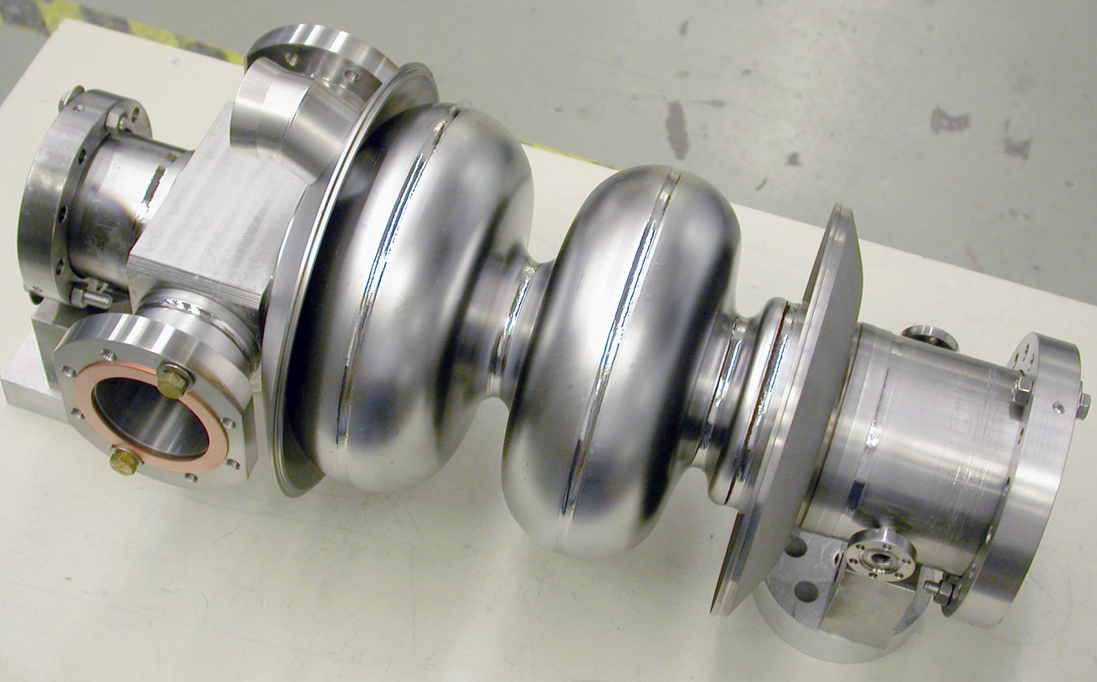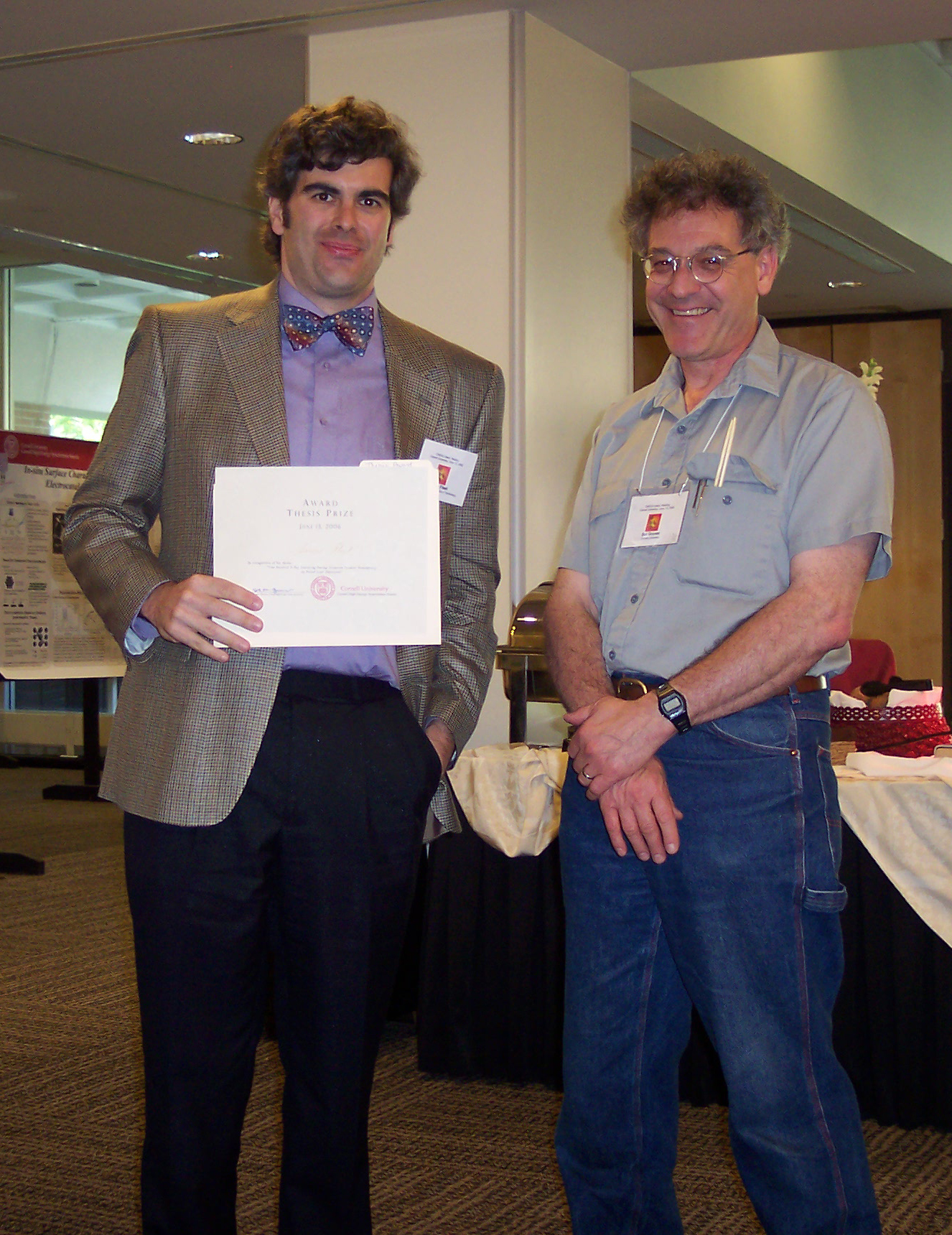X-RAY RUNS: Apply for Beamtime
2017 Nov 1 - Dec 21
2018 Feb 7 - Apr 3
2018 Proposal/BTR deadline: 12/1/17
2018 Apr 11 - Jun 4
2018 Proposal/BTR deadline: 2/1/18
Contact: E. Fontes (ef11@cornell.edu)
July 6, 2006
The 2006 CHESS Users’ Meeting was different than past meetings, explained User’s Executive Committee chair Andrei Sirenko (New Jersey Institute of Technology), because the traditional workshops held during the afternoon and second day were being replaced by almost two full weeks of x-ray science workshops exploring the scientific potential of the Energy Recovery Linac (ERL) - a machine being planned as a future upgrade to the CHESS facility.
Ernest Fontes, CHESS Assistant Director, covered the current status of the storage ring and technical and scientific programs at CHESS, and introduced the concurrent poster session. Don Bilderback, CHESS Associate Director, then discussed x-ray source properties most in need by scientists as motivation for the future ERL light source. He showed users the benefits of a smaller beam, coherent hard x-ray light and high spectral brightness. A tentative site plan for the ERL would extend the existing facility to accommodate a long linear accelerator and at least 18 new beamline sectors. Charlie Sinclair, Project Manager for the ongoing ERL prototype construction, discussed the development of high-brightness high-power electron sources, a necessary prerequisite to realize a brilliant source of continuous x-rays from the ERL. He gave a detailed update on the injector currently being designed and built at Wilson lab. He went over technical issues about photocathode sources, ultra-high vacuum, and discussed the timeline for demonstrating a successful prototype.

The first 2-cell niobium
superconducting RF injector cavity
built for the ERL
prototype.
Sol Gruner, CHESS Director, pointed out that prior speakers had covered where we are, where we want to go, and technical aspects of how we get there. His role, he quipped, defaulted to figuring out how to pay for it all. He noted that the primary CHESS sponsors, the National Science Foundation and the National Institutes of Health, fund a spectrum of activities at Wilson Laboratory in 5-year cycles, most of which are up for renewal in 2008. At that point, the present particle physics experiment at Wilson Laboratory is expected to have completed data collection, opening new opportunities for use of the storage ring. These include shared use of the ring for accelerator physics studies for the International Linear Collider, and continuing dedicated storage ring operations for the CHESS x-ray user program.
The meeting then turned to scientific talks. The first speaker was Oliver Tschauner (University of Nevada at Las Vegas) who spoke about new insights from shock experiments and novel carbon phases in the graphite-diamond and C60 transformation paths. He defined shock experiments as “discontinuous changes in volume” and presented difficult experiments, based on storage ring studies, using gas gun or laser sources for shock waves. Compared to diamond-anvil studies, shock experiments give scientists a view of trapped intermediate states, explore fast time scales, and work on large sample volumes. Tschauner’s group has observed unique, metastable, disordered states in a variety of systems, such as a silica and polymeric C60. In silica, for example, the new phase, found in a recovered 20-micron crystal, consists of the stishovite phase with topological disordered pyramidal and bipyramidal units. An outstanding question is whether intrinsically disordered intermediate structures such as these are a general feature or specific to the systems studied so far. He hopes that in the long term more studies will explore macroscopic disorder intrinsic to transitory states.
Randy Headrick (University of Vermont) explained how pentacene can be used to make non-traditional electronic components, with possible future applications as dramatic as the “live” pictures in the newspapers shown in the Harry Potter movies. Unsolved problems in organic thin film transistors (OTFT) include degradation and sensitivity to water vapor. The SiO2/pentacene interface structure is crucial to its function and little was known before his group’s in-situ growth studies at the CHESS A2 station. At room temperature and moderate vacuum (10-6 Torr), the SiO2 substrate accumulates a layer of water that can be measured using x-ray reflectivity. Heating the sample sublimates the water, but cooling below 100 C to deposit the pentacene allows the water to immediately return from ambient vapor in the vacuum chamber. By studying the growth of a single pentacene monolayer, Headrick’s group confirmed that this 8 Å water layer remains trapped at the SiO2 interface even after pentacene deposition. An additional water layer is also found to form on top of the pentacene layer after deposition. Further investigations are under way to understand how one or the other water layers might affect device performance and degradation.
Noelle Ocon, Associate Conservator of Painting at the North Carolina Museum of Art, changed gears a bit by first explaining what art conservators have to do. Most paintings have been damaged, she related, by water, humidity (warping wooden supports), people and sometimes even dogs! Examples of restoration were stunning. Noelle introduced a painting from their collection that presented a quandary: their valued painting by the Flemish artist David Teniers, The Armorer’s Shop, was recently determined to have been painted on several wood panels. The question now arose if the panels were all painted by the same artist. Noelle’ study of paintings in European collections suggested that the armor may have been painted by a different artist. Conventional tools of the restorer trade were used to compare the paintings without resolving the issue. Confocal x-ray fluorescence (CXRF) analysis at CHESS provided new information about the joint between the two panels. Having depth sensitivity, CXRF created “virtual sections” of the multiple paint layers without destructing any portion. The data collected at CHESS confirmed that the bottom left panel was painted first and that the surrounding composition was completed afterwards, lending strong support to the hypothesis that the painting was done by more one artist. Noelle discussed whether the other artist was either Breugel the Elder or Breugel the Younger.
Christina Bisulca (Winterthur Museum and University of
Delaware)
and Noelle Ocon (North Carolina Museum of
Art), tour the
accelerator tunnel of the Cornell
Electron Storage Ring (CESR).
Kathryn Ferguson, from the department of physiology at the University of Pennsylvania School Of Medicine, spoke on structural details of activation and inhibition of the Epidermal Growth Factor Receptor (EGFR) family of receptor tyrosine kinases (RTKs). The four members of the family of RTKs are implicated in many human cancers and at least five such anti-EGFR antibodies are in clinical trials. Ferguson recalled her first-ever synchrotron run, at CHESS, when excitement kept her awake for two days straight! Her group has recently solved the x-ray crystal structure of the antigen-binding (Fab) fragment from the antibody inhibitor cetuximab (trade name Erbitux) in complex with the soluble extracellular region of EGFR. This work, recently highlighted in Cancer Cell (Vol. 7, 301-311, 2005), produced a model of how cetuximab works, which may be useful in constructing even better EGFR inhibitors for use as anticancer drugs. The complex is difficult to crystallize and only 1 in 20 crystals give good diffraction images; moreover, the crystals have relatively high solvent content (~60%) and damage rapidly in radiation. The best datasets so far have been gathered at the CHESS F1 station, where the x-ray intensity and the high instrument quality combine with the decay rate of the crystals to provide the highest resolution data in the shortest amount of time.
Aaron Fleet was welcomed back to Cornell to be awarded the first CHESS Ph.D. Thesis Prize. Fleet, now Technical Staff Scientist at the Lincoln Laboratory of M.I.T., recalled his years as a graduate student at Cornell under advisor Joel Brock (Applied and Engineering Physics). His talk replayed the story of his project using time resolved x-ray scattering to study strontium titanate homoepitaxy during pulsed laser deposition (PLD). His first viewgraph summarized 6 years of work, he mused. It showed that during a pulse of material landing on a substrate the x-ray intensity of an anti-Bragg reflection first drops rapidly and then recovers over a characteristic time. A fundamental physics question is what happens when energetic particles “crash” into a substrate.

Ph.D.
Thesis Prize recipient Aaron Fleet
and Sol Gruner,
director of CHESS.
Over the course of 3 years, Fleet and fellow graduate student Darren Dale (now a CHESS staff scientist) built a unique instrument at the G3 station to record x-ray data during the pulse. With higher energy, they proposed, incident atoms should have enough momentum to insert themselves into step edges. Careful x-ray data were used to differentiate between different models of film growth. The amplitude of the x-ray intensity dip showed that insertions were certainly happening, and studying the intensity drops as a function of coverage showed the character of the film growth changes with the amount of coverage. Fleet showed some nice animations that modeled diffusion of atoms on the surface and their interaction with step edges and mimicked the experimental data.
A busy poster session and reception followed Aaron’s closing remarks. Suspense grew throughout the session awaiting judges’ decisions for three categories of awards. In the category of “Best Science”, post-doc Xiangyun Qiu accepted the award for coworkers in the group of Lois Pollack (Cornell) for their poster “Measuring Inter-DNA Potentials in Solution.” Their work shows how small-angle scattering studies provide quantitative measures of the forces between isolated DNA molecules. For “Best Instrumentation,” post-doc Peter Busch (Chris Ober/Sol Gruner groups, Cornell) and CHESS staff scientist Arthur Woll took first place with their poster “Science at G1” that illustrated the wide variety of soft condensed matter, biology and biophysics work done with a focused wiggler beam and small-angle scattering. The general category of “Best Graphics” was very competitive and first place went to Cornell Applied and Engineering Physics graduate students Jessica Lamb (for coworkers in the Pollack group) and Sterling Cornaby (for coworkers in the CHESS capillary optics group of Don Bilderback) for their poster “Focusing Optics for use in Small Angle X-ray Scattering Studies of Protein Conformation.” This poster showed how the glass-capillary x-ray optics can provide high x-ray flux into spots 10 microns in size, or smaller, allowing for short exposures on small volume samples. Such a capability is ideal for use in a flow cell where time resolution is determined by beam size and sample volumes are kept small to achieve rapid mixing and conserve material.
Overall, the meeting displayed a great deal of excitement about new capabilities and present and future science at CHESS. Many users remained in Ithaca to participate in workshops examining new science capabilities of the future ERL source.
A
meeting participant takes in a relaxing view of
posters.
